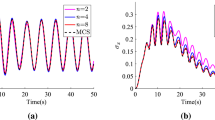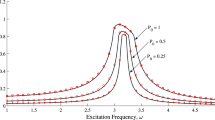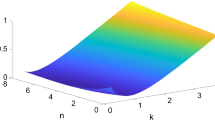Abstract
An approximate analytical technique is developed for determining the non-stationary response amplitude probability density function (PDF) of nonlinear/hysteretic oscillators endowed with fractional derivative elements and subjected to evolutionary stochastic excitation. Specifically, resorting to stochastic averaging/linearization leads to a dimension reduction of the governing equation of motion and to a first-order stochastic differential equation (SDE) for the oscillator response amplitude. Associated with this first-order SDE is a Fokker–Planck partial differential equation governing the evolution in time of the non-stationary response amplitude PDF. Next, assuming an appropriately chosen time-dependent PDF form of the Rayleigh kind for the response amplitude, and substituting into the Fokker–Planck equation, yields a deterministic first-order nonlinear ordinary differential equation for the time-dependent PDF coefficient. This can be readily solved numerically via standard deterministic integration schemes. Thus, the non-stationary response amplitude PDF is approximately determined in closed-form in a computationally efficient manner. The technique can account for arbitrary excitation evolutionary power spectrum forms, even of the non-separable kind. A hardening Duffing and a bilinear hysteretic nonlinear oscillators with fractional derivative elements are considered in the numerical examples section. To assess the accuracy of the developed technique, the analytical results are compared with pertinent Monte Carlo simulation data.






Similar content being viewed by others
References
Oldham, K., Spanier, J.: The Fractional Calculus Theory and Applications of Differentiation and Integration to Arbitrary Order. Academic Press, New York (1974)
Sabatier, J., Agrawal, O.P., Machado, J.A.T.: Advances in Fractional Calculus: Theoretical Developments and Applications in Physics and Engineering. Springer, Berlin (2007)
Rossikhin, Y.A., Shitikova, M.V.: Application of fractional calculus for dynamic problems of solid mechanics: novel trends and recent results. Appl. Mech. Rev. 63, 010801–52 (2010)
Di Paola, M., Failla, G., Pirrotta, A., Sofi, A., Zingales, M.: The mechanically based non-local elasticity: an overview of main results and future challenges. Philos. Trans. R. Soc. A 371(1993), 20120433 (2013)
Tarasov, V.E.: Fractional mechanics of elastic solids: continuum aspects. J. Eng. Mech. 143(5), D4016001–8 (2017)
Di Paola, M., Pirrotta, A., Valenza, A.: Visco-elastic behavior through fractional calculus: an easier method for best fitting experimental results. Mech. Mater. 43(12), 799–806 (2011)
Koh, C.G., Kelly, J.M.: Application of fractional derivatives to seismic analysis of base-isolated models. Earthq. Eng. Struct. Dyn. 19(2), 229–241 (1990)
Lee, H.H., Tsai, C.-S.: Analytical model of viscoelastic dampers for seismic mitigation of structures. Comput. Struct. 50(1), 111–121 (1994)
Shen, K.L., Soong, T.T.: Modeling of viscoelastic dampers for structural applications. J. Eng. Mech. 121(6), 694–701 (1995)
Rüdinger, F.: Tuned mass damper with fractional derivative damping. Eng. Struc. 28(13), 1774–1779 (2006)
Makris, N., Constantinou, M.C.: Fractional-derivative Maxwell model for viscous dampers. J. Struct. Eng. 117(9), 2708–2724 (1991)
Spanos, P.D., Zeldin, B.A.: Random vibration of systems with frequency-dependent parameters or fractional derivatives. J. Eng. Mech. 123(3), 290–292 (1997)
Shokooh, A., Suárez, L.: A comparison of numerical methods applied to a fractional model of damping materials. J. Vib. Control 5(3), 331–354 (1999)
Agrawal, O.P.: Stochastic analysis of dynamic systems containing fractional derivatives. J. Sound Vib. 5(247), 927–938 (2001)
Agrawal, O.P.: Analytical solution for stochastic response of a fractionally damped beam. J. Vib. Acoust. 126(4), 561–566 (2004)
Huang, Z.L., Jin, X.L.: Response and stability of a SDOF strongly nonlinear stochastic system with light damping modeled by a fractional derivative. J. Sound Vib. 319(3–5), 1121–1135 (2009)
Spanos, P.D., Evangelatos, G.I.: Response of a non-linear system with restoring forces governed by fractional derivatives - Time domain simulation and statistical linearization solution. Soil Dyn. Earthq. Eng. 30(9), 811–821 (2010)
Chen, L., Zhu, W.: Stochastic jump and bifurcation of Duffing oscillator with fractional derivative damping under combined harmonic and white noise excitations. Int. J. Non-Linear Mech. 46(10), 1324–1329 (2011)
Di Paola, M., Failla, G., Pirrotta, A.: Stationary and non-stationary stochastic response of linear fractional viscoelastic systems. Probab. Eng. Mech. 28, 85–90 (2012)
Failla, G., Pirrotta, A.: On the stochastic response of a fractionally-damped Duffing oscillator. Commun. Nonlinear Sci. Numer. Simul. 17(12), 5131–5142 (2012)
Di Lorenzo, S., Di Paola, M., Pinnola, F.P., Pirrotta, A.: Stochastic response of fractionally damped beams. Probab. Eng. Mech. 35, 37–43 (2014)
Spanos, P.D., Malara, G.: Nonlinear random vibrations of beams with fractional derivative elements. J. Eng. Mech. 140(9), 04014069–10 (2014)
Di Matteo, A., Kougioumtzoglou, I.A., Pirrotta, A., Spanos, P.D., Di Paola, M.: Stochastic response determination of nonlinear oscillators with fractional derivatives elements via the Wiener path integral. Probab. Eng. Mech. 38, 127–135 (2014)
Spanos, P.D., Kougioumtzoglou, I.A., dos Santos, K.R.M., Beck, A.T.: Stochastic averaging of nonlinear oscillators: Hilbert transform perspective. J. Eng. Mech. 144(2), 04017173 (2017)
Liaskos, K., Pantelous, A.A., Kougioumtzoglou, I.A., Meimaris, A.T.: Implicit analytic solutions for the linear stochastic partial differential beam equation with fractional derivative terms. Syst. Control Lett. 121, 38–49 (2018)
Kougioumtzoglou, I.A., Spanos, P.D.: Harmonic wavelets based response evolutionary power spectrum determination of linear and non-linear oscillators with fractional derivative elements. Int J. Non-Linear Mech. 80, 66–75 (2016)
Kougioumtzoglou, I.A., dos Santos, K.R.M., Comerford, L.: Incomplete data based parameter identification of nonlinear and time-variant oscillators with fractional derivative elements. Mech. Syst. Signal Process. 94, 279–296 (2017)
Kougioumtzoglou, I.A., Spanos, P.D.: An approximate approach for nonlinear system response determination under evolutionary stochastic excitation. Curr. Sci. 97, 1203–1211 (2009)
Roberts, J.B., Spanos, P.D.: Stochastic averaging: an approximate method of solving random vibration problems. Int. J. Non-Linear Mech. 21(2), 111–134 (1986)
Roberts, J.B., Spanos, P.D.: Random Vibration and Statistical Linearization. Dover Publications, New York (2003)
Di Matteo, A., Spanos, P.D., Pirrotta, A.: Approximate survival probability determination of hysteretic systems with fractional derivative elements. Probab. Eng. Mech. 54, 138–146 (2018)
Spanos, P.D., Di Matteo, A., Cheng, Y., Pirrotta, A., Li, J.: Galerkin scheme-based determination of survival probability of oscillators with fractional derivative elements. J. Appl. Mech. 83(12), 121003–9 (2016)
Li, W., Chen, L., Trisovic, N., Cvetkovic, A., Zhao, J.: First passage of stochastic fractional derivative systems with power-form restoring force. Int. J. Non-Linear Mech. 71, 83–88 (2015)
Solomos, G.P., Spanos, P.T.D.: Oscillator response to nonstationary excitation. J. Appl. Mech. 51(4), 907–912 (1984)
Kougioumtzoglou, I.A.: Stochastic joint time-frequency response analysis of nonlinear structural systems. J. Sound Vib. 332(26), 7153–7173 (2013)
Tubaldi, E., Kougioumtzoglou, I.A.: Nonstationary stochastic response of structural systems equipped with nonlinear viscous dampers under seismic excitation. Earthq. Eng. Struct. Dyn. 44(1), 121–138 (2015)
dos Santos, K.R.M., Kougioumtzoglou, I.A., Beck, A.T.: Incremental dynamic analysis: a nonlinear stochastic dynamics perspective. J. Eng. Mech. 142(10), 06016007–7 (2016)
Spanos, P.D., Giaralis, A., Politis, N.P., Roesset, J.M.: Numerical treatment of seismic accelerograms and of inelastic seismic structural responses using harmonic wavelets. Comput. Aided Civil Infrastruct. Eng. 22(4), 254–264 (2007)
Beck, J.L., Papadimitriou, C.: Moving resonance in nonlinear response to fully nonstationary stochastic ground motion. Probab. Eng. Mech. 8(3–4), 157–167 (1993)
Mitseas, I.P., Kougioumtzoglou, I.A., Beer, M.: An approximate stochastic dynamics approach for nonlinear structural system performance-based multi-objective optimum design. Struct. Saf. 60, 67–76 (2016)
Spanos, P.-T.D., Lutes, L.D.: Probability of response to evolutionary process. J. Eng. Mech. Div. 106(2), 213–224 (1980)
Grigoriu, M.: Stochastic Calculus: Applications in Science and Engineering. Springer, Birkhäuser (2002)
Grigoriu, M.: Stochastic Systems: Uncertainty Quantification and Propagation. Springer, London (2012)
Spanos, P.-T.D., Solomos, G.P.: Markov approximation to transient vibration. J. Eng. Mech. 109(4), 1134–1150 (1983)
Liang, J., Chaudhuri, S.R., Shinozuka, M.: Simulation of nonstationary stochastic processes by spectral representation. J. Eng. Mech. 133(6), 616–627 (2007)
Caughey, T.K.: Random excitation of a system with bilinear hysteresis. J. Appl. Mech. 27(4), 649–652 (1960)
Zhu, W.Q., Cai, G.Q., Hu, R.C.: Stochastic analysis of dynamical system with double-well potential. Int. J. Dyn. Control 1(1), 12–19 (2013)
Bellizzi, S., Bouc, R.: Analysis of multi-degree of freedom strongly non-linear mechanical systems with random input: part I: non-linear modes and stochastic averaging. Probab. Eng. Mech. 14(3), 229–244 (1999)
Di Paola, M., Pinnola, F.P., Spanos, P.D.: Analysis of multi-degree-of-freedom systems with fractional derivative elements of rational order. In: ICFDA’14 International Conference on Fractional Differentiation and its Applications, pp. 1–6, IEEE (2014)
Author information
Authors and Affiliations
Corresponding author
Ethics declarations
Conflict of interest
The authors declare that they have no conflict of interest.
Additional information
Publisher's Note
Springer Nature remains neutral with regard to jurisdictional claims in published maps and institutional affiliations.
Appendix
Appendix
In this appendix, more details on the derivation of Eqs. (12) and (13) are included for completeness, while the interested reader is also directed to Refs [32, 33]. In this regard, Eqs. (10) and (11) are rewritten, equivalently, in the form
and
where S(A) and F(A) are given by Eqs. (14) and (15), respectively. Further,
and
In general, the fractional derivative of order \(\alpha \) for the cosine function is given by
where \(0<\alpha <1\). Determining analytically the integrals defined in Eqs. (54) and (55) by employing Eq. (56) is not straightforward, as it involves the evaluation of rather complex integral forms. Nevertheless, appropriately approximating Eqs. (54) and (55) facilitates significantly the related computations. In particular, assuming that the time parameter \(\tau \) takes small values, Eq. (4) becomes [32, 33]
Next, combining Eq. (57) with Eq. (2), the Caputo derivative defined in Eq. (2) takes the form
Further, utilizing the integrals [33]
and
Equation (58) becomes
Equation (61) constitutes an approximate expression that facilitates the determination of fractional derivatives of order \(0<\alpha <1\), and thus, it is utilized in simplifying the integrands of Eqs. (54) and (55), which become
and
respectively. Finally, Eqs. (12) and (13) are derived by considering Eqs. (62) and (63).
Rights and permissions
About this article
Cite this article
Fragkoulis, V.C., Kougioumtzoglou, I.A., Pantelous, A.A. et al. Non-stationary response statistics of nonlinear oscillators with fractional derivative elements under evolutionary stochastic excitation. Nonlinear Dyn 97, 2291–2303 (2019). https://doi.org/10.1007/s11071-019-05124-0
Received:
Accepted:
Published:
Issue Date:
DOI: https://doi.org/10.1007/s11071-019-05124-0




